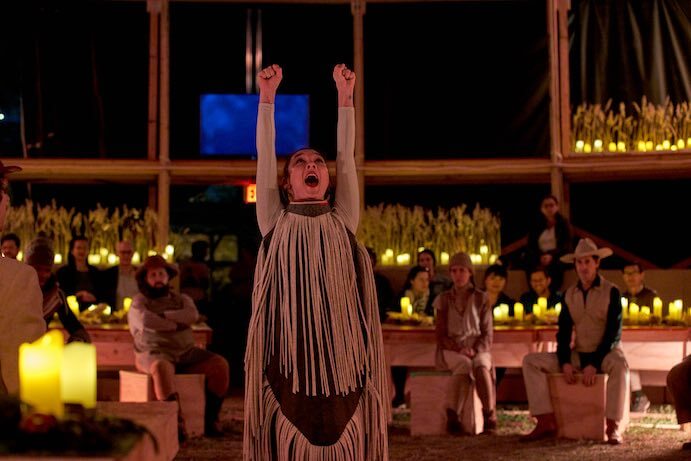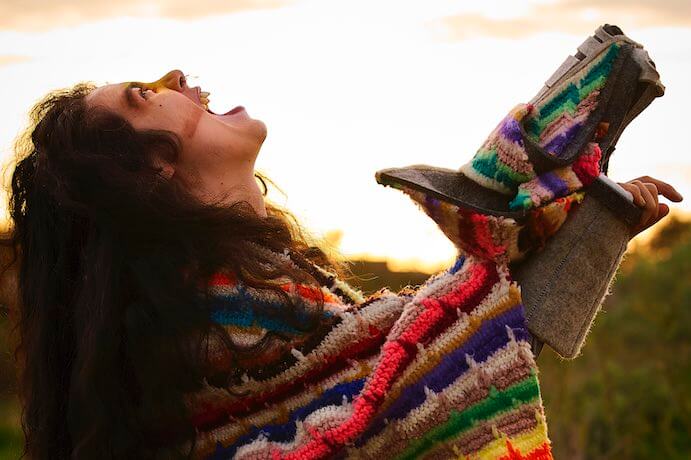Sweet Land was originally an immersive “historical pageant” opera presented in Los Angeles, March 2020, ready to take its place in The Industry’s pantheon of acclaimed productions. When Sweet Land’s audience arrived at Los Angeles State Historic Park, they were collectively welcomed and then split into two tracks for divergent experiences of America’s indigenous Hosts and foreign Arrivals. Engaging both tracks required two separate visits, though after encountering the head-spinning and sensually luxurious piece, the L.A. Times’ Mark Swed did not recommend going twice in one day.
Then COVID-19 cancelled Sweet Land’s sold-out run. The creative team quickly adapted the opera’s tracks into individual opera films, in which viewers are guided by Coyotes (Micaela Tobin and Carmina Escobar) between the original opera set and various park locations. Film as an artistic medium focuses Sweet Land in a way that was never intended: the experiences can be paused or rewound at will. I promised myself I would let the films play uninterrupted to imitate a live viewing, but just a few minutes in, I instinctively stopped the video to catch a subtitle and realized this effort was foolish. Even an opera as immersive as this now seems traditional–dare I say quaint–in that we traditionally assembled in close physical proximity.
The opera presents an abstract exploration of human relations on Turtle Island (North America), including the United States’ construction of identity. In both tracks, small parties of the groups conflict after initial contact, ending in indigenous destruction that is remembered by a surviving warrior woman. The “Feast” track, noting hospitality as a social fulcrum, depicts indigenous Hosts feeding famished cowboy-styled Arrivals. The Arrivals take without thanks, refusing any indigenous respect or reciprocity and explicitly demanding to split the earth open. The Hosts initially drive the Arrivals away, but they are unable to withstand violent greed; we learn the land has been renamed “Sweet” and experience the indigenous fate through a native warrior’s memories (Kelci Hahn). Arrivals continue their westward “Train” expansion later in history, with weaponized religion and warrior Bow’s bitter memorial (Lindsay Patterson Abdou) sung over relentless percussion.
Turtle Island (North America) is the true star. It is the suffering host of the violent drama that unfolds between its native kin, foreign colonizers, and immigrants to the United States. The film’s opening moments offer a drone shot of daytime Los Angeles, bathed in light with the glittering city skyline and busy highways, before zooming into its green landscape. We meet the Coyote guides there, and we finish the film there with wildlife and a small child in the shadows of detritus and abandoned green space. Supertitled singers tell of a massacre by greedy white colonizers who have also raped the land: “The land is unresponsive… her legs tightly closed.”

Sweet Land–Photo by Casey Kringlen for The Industry
Between Sweet Land’s first and final moments of acapella voices is orchestration that manages to hide in plain sight. The production’s pivot to film transformed the music into a film score, and it is perfectly suited: cinematic, punctuated, and fleeting. Du Yun, a Chinese-born immigrant, and Raven Chacon of Fort Defiance, Navajo Nation co-composed music that weaves tight notation with urgent improvisational interludes. The human voice is the featured instrument: stratospheric soprano and countertenor, multi-pitched chanting, hymnody, and distorted articulation curve through an orchestral landscape of extreme timbres and movement. Rhythm unfurls and drives but, like the human behavior, rarely locks into a groove.
The music is cohesive, but Du Yun and Chacon reinforce Aja Couchois Duncan and Douglas Kearney’s libretto: the way forward is not cultural domination or dilution but co-existence. Madrigals, swing, cante jondo, “oriental music,” Motown, brass band, and Americana are a few of the discrete, ironic styles used to characterize or comment on the aggressive tale. Minimal electronics are deployed for the ceremonial dancer; the Host’s defense is accompanied by complicated modern harmony, rhythm, and timbre. There is indeed a clash of old and new, but it is the Arrivals who are regressive, and their behavior is as predictable as their harmonic progressions.
Co-directors Yuval Sharon and Cannupa Hanska Luger, discussing mythmaking in the program notes, say that Sweet Land lives in “that indeterminate space between the concrete and the abstract,” which is neither comfortable nor wholly unified. Since social situations are complicated, we must ask how we can see ourselves as part of and accountable for all sides.

Sweet Land–Photo by Casey Kringlen for The Industry
It is a question and tension which sits as resolutely in music industry values and audience relationships as it does in judgement of history. Both versions of Sweet Land are visually fantastic and offer different accessibility options or barriers. Both offer prismatic, rainbow costumes. In addition to rich visual and movement textures, the original immersive experience offered outdoor smells and an orchestration that includes percussive vibrations accessible for D/deaf audiences.
One of the notable changes in the film translation–perhaps the notable improvement–is the fully sub- or supertitled libretto. The text was difficult to catch even with a pause button and a 41-page digital program at hand. I imagine the original production was fragmentary to a hearing person, limited and challenging for a D/deaf or hearing-impaired attendee, and nigh impossible to follow for someone with visual impairment. Film also allowed for fleeting but proper recognition of the musicians’ contributions, as “Train” provided closeups of the irreplaceable and demanding percussion work.
Sweet Land explicitly offers an uncomfortable, incomplete, and at times incomprehensible hospitality. If, however, its goal was wondrous physicality juxtaposed with severe abstraction, then Sweet Land succeeds in both forms, finding its zenith in the provocative line, “All you’ve seen, what you remember doesn’t matter.” It was originally sung by the colonial character Jimmy Gin to wage war on the indigenous people, and the line twists into a poignant stamp of the opera’s own legacy. Whether in memories of the live experience or in Sweet Land’s self-editing film, it seems unavoidable that this opera mythologizes itself.






















